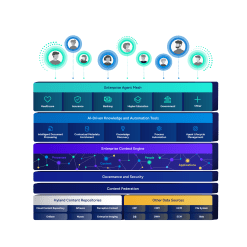Enterprise considerations
Now that we have explored the difference between commodity and custom models and have examined some real-world use cases for AI, ML and content, let’s look at some key considerations for organizations considering a content management platform with enterprise-class AI and ML capabilities.
AI governance
When it comes to governing AI, organizations aren’t keeping pace. Forrester reports:
- Only 19% of organizations govern AI-generated content.
- Only 23% govern the prompts used to generate content.
- Decision-makers need to mitigate the complexity involved in surfacing, governing and deriving insights from content across the enterprise.
AI capabilities require data governance for several reasons, including to protect sensitive information, address ethical considerations, prevent biased results, identify and mitigate risks, and manage entire data lifecycles properly. Mishandling of data by unregulated AI sources may lead to inaccuracy in reporting, data breaches and noncompliance with governance data protection regulations, ethical concerns such as lack of transparency and eventually, a negative public perception.
When onboarding AI into an enterprise content strategy, the platform should allow teams to:
- Select and oversee what data AI models have access to
- Approve which authorized personnel can view and control data, in its original form or through AI-generated content
- Decide how the predictions and outputs provided by AI models can be applied
We also recommend an enterprise content platform that has extensive experience in handling highly sensitive data while adhering to differing industry standards. Enterprise content platforms with stringent data governance policies help protect sensitive information and ensure compliance with data privacy regulations such as GDPR, CCPA and HIPAA, which are enforced in sectors like government, healthcare and the financial industry.
Continuous training and administration
Another critical consideration is how your AI models perform over time.
First, you should consider solutions that utilize continuous training paradigms that enable your ML models to evolve and improve over time as new content and data is added to the system. Human interaction with machine-generated data is also critical to provide data validation and further train ML models. Look for a content solution platform that considers the human role in the machine-learning process and provides specific interfaces for “human in the loop” training.
Your AI solution should also provide real-time performance monitoring for models. ML models can begin to show bias or even degraded performance; therefore, a performance monitoring interface will help identify models that have become corrupted or are showing degradation in performance. Machine-learning models should also be versioned, allowing you to quickly roll back to an earlier version should your model become degraded.





















